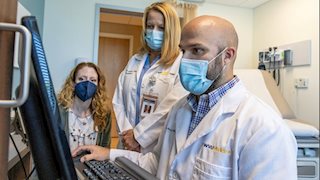
Imagine being unable to tie your shoes, write, type, or drink from a cup because of involuntary shaking in your hands. For 25 years, Jim Hudson, 68, of Moundsville, West Virginia, struggled with basic tasks that required the use of his hands. A movement disorder had taken control of his life.
In his early 30s, he developed essential tremor, a neurological condition that causes a person’s hands, head, trunk, voice, or legs to shake. It is often confused with Parkinson’s disease. “My whole life I’ve done my own mechanic work, worked on things around the house, carpentry work, and welding. To lose all of that ability was completely devastating,” Jim said.
Essential tremor first showed up in his left hand. Once tremors began in his right hand too, his abilities were increasingly limited, and he became dependent on other people for help. Eating a meal required so much effort for Jim. “It got to the point where my wife and I were eating dinner in shifts,” he said. “She’d eat, and then help me. There were times where I was really worn out after I ate.”
His mounting anxiety and frustration with the tremors only seemed to make things worse. As the disease progressed, Jim lost the ability to respond to medication and side effects zapped his energy. “I’d go out for a run, and it felt like I hadn’t slept for two days,” he said.
Despite his limitations, Jim continued to teach welding at John Marshall High School in Glendale, West Virginia. “I told my students up front, ‘Hey, I can’t do this anymore because I have essential tremor,’” Jim said. “I still have the knowledge, so I worked with the students individually, and it got the job done. But as far as getting in there and actually showing them, I wasn’t able to do it anymore.”
His social activities also deteriorated because of the stress and self-consciousness of living with essential tremor. “I couldn’t go out for breakfast in the morning with my wife anymore,” Jim said. “People see you shaking, and they’d say, ‘Well, you need a drink.’ It’s not that I need a drink; it’s just that I need to quit shaking.”
When his family doctor, WVU Medicine Reynolds Memorial Hospital CEO David Hess, MD, referred him to WVU Medicine neurologist Ann Murray, MD, she told Jim that it was time to consider deep brain stimulation, a form of neuromodulation that uses the latest technology to alter and improve functions of the human nervous system. Deep brain stimulation is performed with a small incision to implant electrodes in certain areas of the brain to control the abnormal impulses that cause movement disorders.
Jim avoided deep brain stimulation for many years after watching a TV show that gave him the wrong impression about the procedure. After a thorough assessment with Dr. Murray and WVU Medicine neurosurgeon Nicholas Brandmeir, MD, they eased his concerns and cleared up myths that Jim had heard about the procedure. Jim was willing to give it a try if deep brain stimulation could restore his independence and social life.
“When we talk about brain surgery, it sounds scary and we understand that,” Dr. Brandmeir said. “If patients are really suffering with a movement disorder, the best thing to do is come see us for an educational visit. We’re not going to talk about signing up for surgery on the first visit. Bring a list of questions you have, we’ll help you learn firsthand what deep brain stimulation is all about, and you can decide whether it’s right for you.”
Jim underwent two outpatient surgeries with two-week breaks in between and one surgery with an overnight stay. The level of deep brain stimulation is regulated with a small device similar to a pacemaker that is placed under the skin of the upper chest area. Movement disorder patients may continue to experience tremors post-surgery until the entire process is complete and the deep brain stimulation device is activated.
“In the recovery room, his tremor was largely gone, and Jim couldn’t even express how excited he was,” Dr. Brandmeir said. “To be able to give that life-changing experience to people is extremely gratifying. It’s the best part of my job.”
When Jim returned to WVU Medicine to have the deep brain stimulation device activated, he held his arms out in the air, and for the first time in 25 years, there was no shaking in either hand. He could write his name again, too. Tears flowed from his eyes.
“Deep brain stimulation is a game changer,” Jim said. “The fact that I can do simple things now is such a big deal.” Jim is finally enjoying his retirement to the fullest. He and his wife Cindy enjoy spending time with their two grandchildren, attending their grandchildren’s baseball games, and going on camping trips.
“Deep brain stimulation is well worth it because of the life-changing, end results,” Jim said. “Thinking of how I suffered and lost my temper struggling with the shaking – knowing what I know now, I would have had it done 10 years ago.”
Learn more: WVUMedicine.org/neuromod
Here at WVU Medicine, we’re saving lives, improving health, and working to make a difference in our state and region. If you have a great story to tell, we’d like to hear it.


